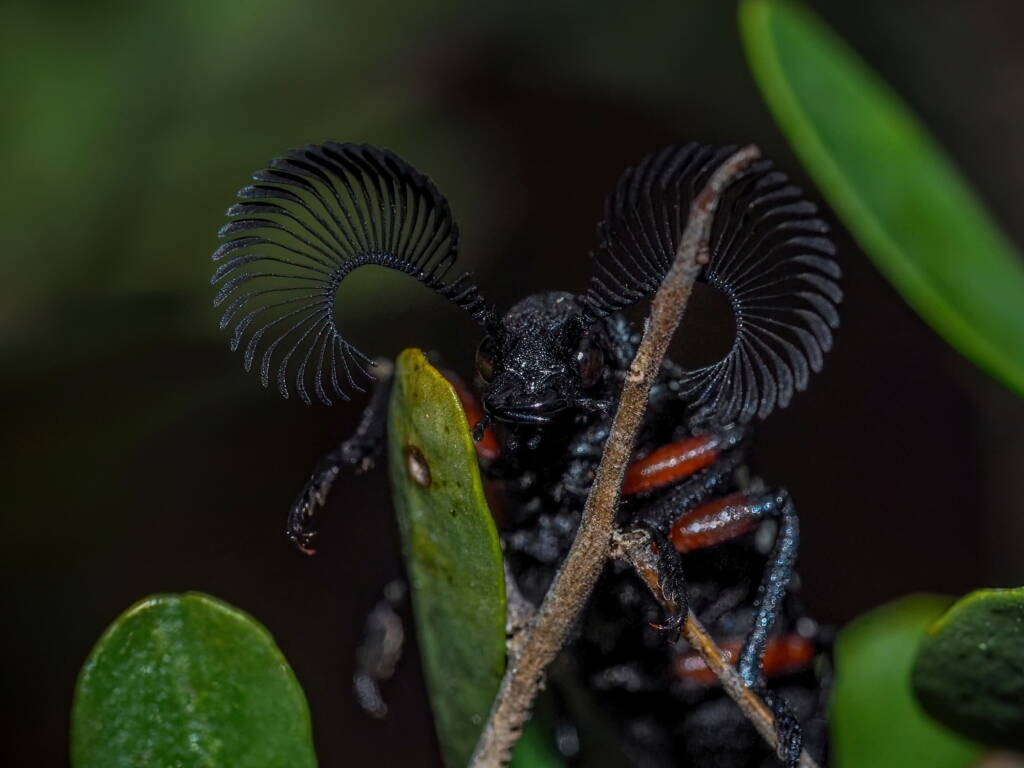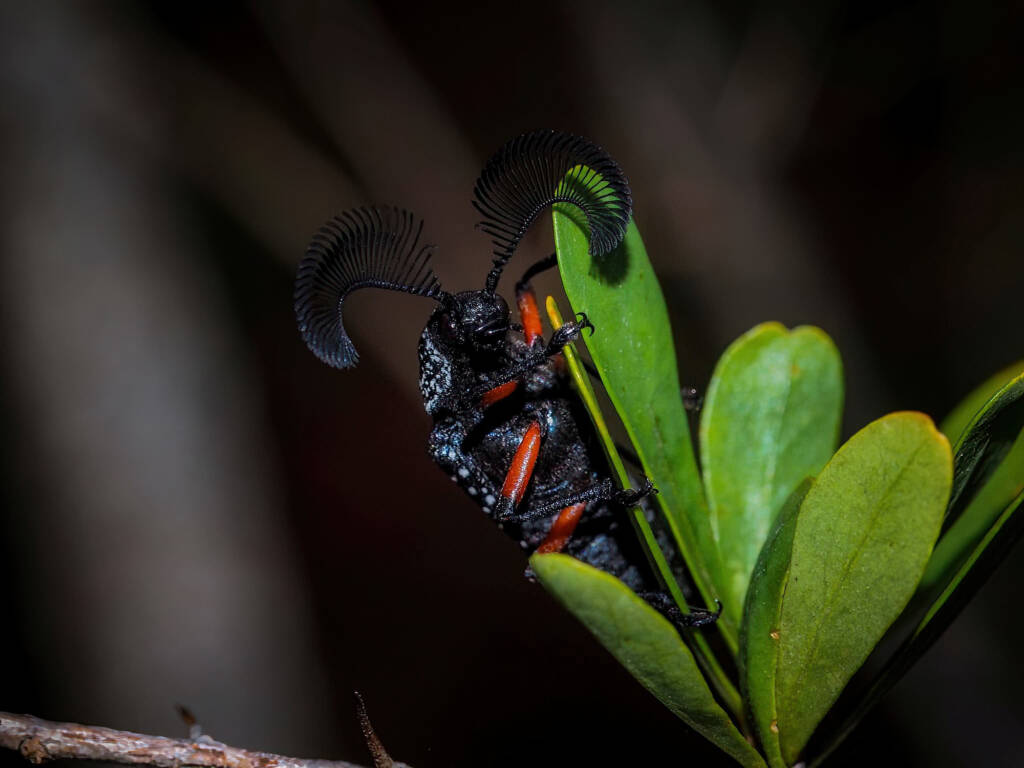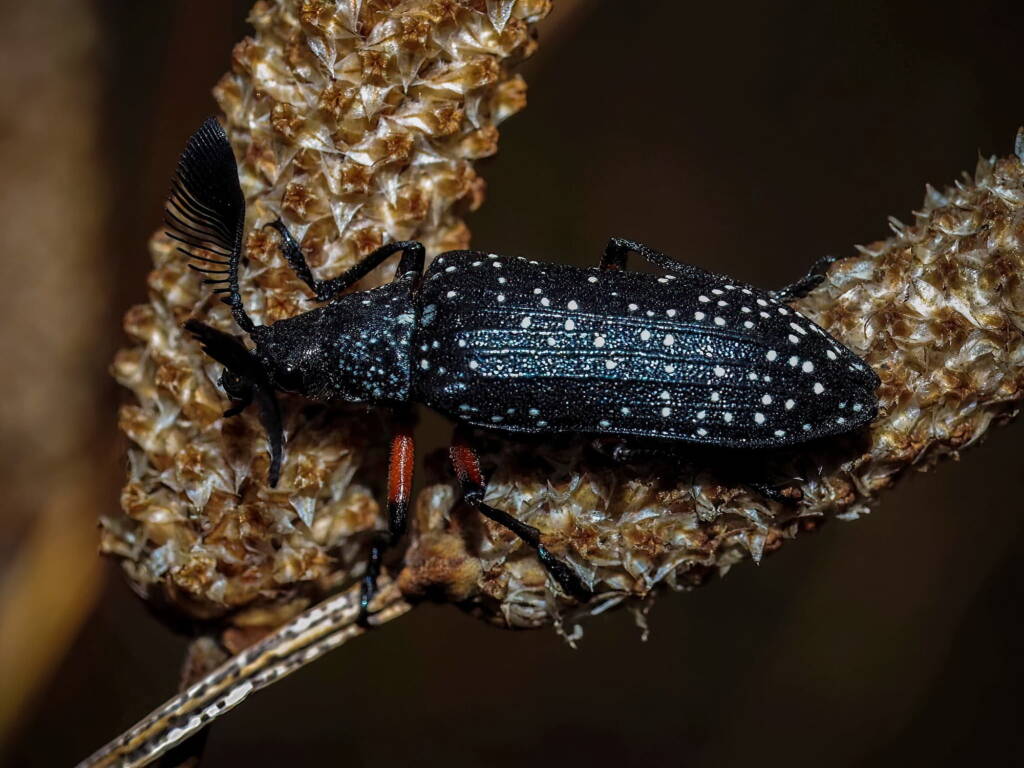RhipiceridaeFeather-horned Beetle (Rhipicera carinata) Feather-horned Beetle (Rhipicera femorata)
The Feather-horned Beetle (Rhipicera femorata) is one of five described species in the subgenus Rhipicera (Agathorhipis). A beautiful and interesting beetle found along the east coast from southern Queensland, New South Wales, Victoria, parts of South Australia, southwest Western Australia and Tasmania.
The Rhipicera (Agathorhipis) femorata pictured here are from the Southern Fleurieu Peninsula region of South Australia.

Finally managed to take some decent snaps of Rhipicera femorata in low light and windy conditions yesterday. The air temperature was quite cool at 17c but that doesn’t deter this beetle looking for his mate.
In SA, we recently experienced 3 warm consecutive days followed by a wet cool change down the Southern Fleurieu. They’re out in full force, mainly on Bursaria and grasses. Found in gullies.
Very chilled out and easy to photograph, delightful beetles. Full of personality and charm.
Source: Nomes Naomi Betts



Rhipicera femorata are black with white spots on the body. They have over-sized fan-like antennae. In the males they are much larger and more pronounced than in the females. The antennae of the males are used to locate female beetle, when she is emitting a mating pheromone. The adults are about 1 to 2.5 cm in length.
Both the larvae and adults are said to feed on the roots and leaves of their host plant, mainly eucalypts. Whilst they are found in open eucalypt forests, the beetle pictured above were found on the shrubs in the genus Bursaria, whilst those below were on native grasses.
- Scientific classification
- Kingdom: Animalia
- Phylum: Arthropoda
- Subphylum: Hexapoda
- Class: Insecta
- informal: Pterygotes
- Order: Coleoptera
- Suborder: Polyphaga
- Superfamily: Dascilloidea
- Family: Rhipiceridae
- Genus: Rhipicera
- Subgenus: Rhipicera (Agathorhipis)
- Species:
- Rhipicera (Agathorhipis) attenuata Westwood, 1843
- Rhipicera (Agathorhipis) femorata Kirby, 1818
- Rhipicera (Agathorhipis) mystacina (Fabricius, 1775)
- Rhipicera (Agathorhipis) neglecta Emden, 1925
- Rhipicera (Agathorhipis) reichei Guérin-Méneville, 1843
Footnote & References
- Photographs © Nomes Naomi Betts
- Australasian Beetles Only, Facebook group, https://www.facebook.com/groups/1180404322409639/
- Feather-horned Beetle (Rhipicera femorata), iNaturalistAU, https://inaturalist.ala.org.au/taxa/505450-Rhipicera-femorata
- Rhipicera (Agathorhipis) femorata Kirby, 1818, Atlas of Living Australia, https://bie.ala.org.au/species/https://biodiversity.org.au/afd/taxa/3315dd4e-2c15-40b6-a479-f0e4086c13f2
- Rhipicera (Agathorhipis) femorata, Canberra Nature Map, https://canberra.naturemapr.org/species/11616
- Rhipicera (Agathorhipis) femorata Kirby, 1818, Feather-horned Beetle, Museums Victoria Collections, https://collections.museumsvictoria.com.au/species/15128
RhipiceridaeFeather-horned Beetle (Rhipicera carinata) Feather-horned Beetle (Rhipicera femorata)
ColeopteraAmarygmus sp Anoplognathus sp Christmas Beetle (Anoplognathus macleayi) Anoplognathus porosus Aphanestes gymnopleura Buprestidae More Buprestidae Jewel Beetles Astraeus Calodema plebeia Castiarina Cyrioides Diadoxus Diphucrania Melobasis Merimna atrata Metaxymorpha gloriosa Stigmodera Temognatha Torresita cuprifera Cerambycidae Didymocantha obliqua Pachydissus sp Rhytiphora Coleoptera (Beetles) Curculionidae Chrysolopus spectabilis (Botany Bay Diamond Weevil) Lixus Perperus lateralis (White-striped Weevil) Digitonthophagus gazella Dung Beetle Eretes australis Helea scaphiformis Johannica gemellata (Pandorea Leaf Beetle) Ladybirds (Beetles) Australoneda bourgeoisi Coccinella transversalis Cryptolaemus montrouzieri Harmonia conformis Olla v-nigrum Orcus australasiae Lepidiota Lucanidae Lamprima aurata Prosopocoilus torresensis Neospades sp Lycidae Omorgus Paropsine Beetle Paropsis maculata Paropsis porosa Paropsis sospita Paropsisterna sp Paropsisterna beata Paropsisterna m-fuscum Paropsisterna pictipes Pittosporum Leaf Beetle (Lamprolina impressicollis) Protaetia fusca Pterohelaeus sp Rhipiceridae Feather-horned Beetle (Rhipicera carinata) Feather-horned Beetle (Rhipicera femorata) Scarabaeidae Scarabaeinae (Dung Beetles) Xylophilostenus octophyllus
InsectsBees Beetles Blattodea Butterflies Coleoptera Cicada Crabronidae Diptera Dragonflies & Damselflies Formicidae Hemiptera Heteroptera (True Bugs) Mango Planthopper Moths Orthoptera Orthopteroid Processionary Caterpillar Stink Bugs, Shield Bugs and Allies Syrphidae Wasps Water Scorpion (Laccotrephes tristis) Witchetty Grub




